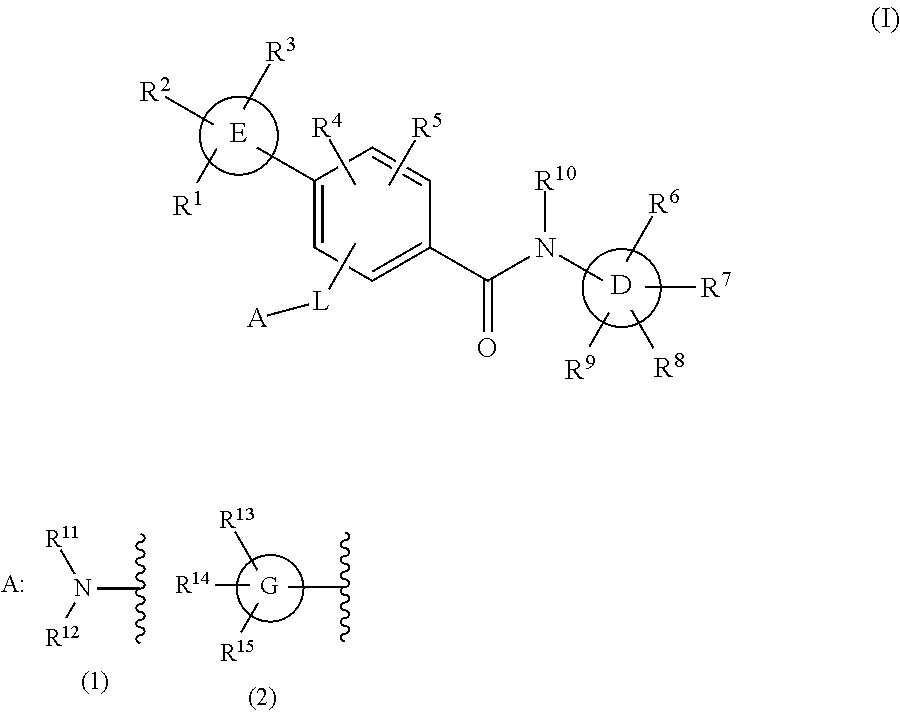Biaryl amide derivative or pharmaceutically acceptable salt thereof
a technology of biaryl amide and derivatives, applied in the field of biaryl amide derivatives, to achieve the effect of reducing side effects, high binding affinity for and antagonistic activity
- Summary
- Abstract
- Description
- Claims
- Application Information
AI Technical Summary
Benefits of technology
Problems solved by technology
Method used
Image
Examples
preparation 1
[0454]
[In the scheme, X1 is hydroxy group or a leaving group (e.g. halogen atom such as chlorine atom, bromine atom or iodine atom, etc.). X is a leaving group (e.g. halogen atom such as bromine atom or iodine atom, or sulfonyloxy group such as trifluoromethanesulfonyloxy, etc.). M is boronic acid (B(OH)2) or boronic acid ester, or organotin (e.g. Sn(n-Bu)4, etc.), or other alkaline-earth metals which form appropriate organometal compounds (e.g. magnesium, zinc, etc.). Each of other symbols is the same as defined in the above Item 1.]
Step 1:
[0455]It may be synthesized, if necessary, by activating a compound of formula (A-2) wherein X1 is hydroxy group or a salt thereof in an inactive solvent to react with a compound of formula (A-1) or a salt thereof in the presence of a base, if necessary. A method for activating a compound of formula (A-2) or a salt thereof includes, for example, a method for converting its carboxy group to an acid halide, a mixed acid anhydride, etc., or a method...
preparation 2
[0480]
(In the scheme, R1′ is hydrogen atom, methyl group, ethyl group, tert-butyl group or benzyl group, etc., and other symbols are the same as defined above.)
Step 1:
[0481]Organometal compound (A-4) and Compound (A-11) or a salt thereof may be treated in the similar manner to the method of Step 2 in Preparation 1 to give Compound (A-12). When R1′ is hydrogen, Compound (A-12) is the same as Compound (A-2) wherein X1 is hydroxy group, and in that case, Step 2 is abbreviated.
Step 2:
[0482]The present step is a step for converting Compound (A-12) wherein R1′ is not hydrogen atom to a carboxylic compound of Compound (A-2) wherein X1 is hydroxy group by deprotecting an ester group. Compound (A-2) wherein X1 is hydroxy group may be also treated in the similar manner to the method of Step 1 in Preparation 1 to give an acid halide of formula (A-2) wherein X1 is halogen such as chlorine.
[0483]The present step may be carried out according to the general method of a literature (e.g., Protective...
preparation 3
[0487]
(In the scheme, symbols are the same as defined above.)
Step 1:
[0488]Organometal compound (A-13) and Compound (A-6) or a salt thereof may be treated in the similar manner to the method of Step 2 in Preparation 1 to give Compound (A-12). Compound (A-3) or a salt thereof may be prepared, for example, according to the following method.
PUM
| Property | Measurement | Unit |
|---|---|---|
| temperature | aaaaa | aaaaa |
| temperature | aaaaa | aaaaa |
| temperature | aaaaa | aaaaa |
Abstract
Description
Claims
Application Information
 Login to View More
Login to View More - R&D
- Intellectual Property
- Life Sciences
- Materials
- Tech Scout
- Unparalleled Data Quality
- Higher Quality Content
- 60% Fewer Hallucinations
Browse by: Latest US Patents, China's latest patents, Technical Efficacy Thesaurus, Application Domain, Technology Topic, Popular Technical Reports.
© 2025 PatSnap. All rights reserved.Legal|Privacy policy|Modern Slavery Act Transparency Statement|Sitemap|About US| Contact US: help@patsnap.com



